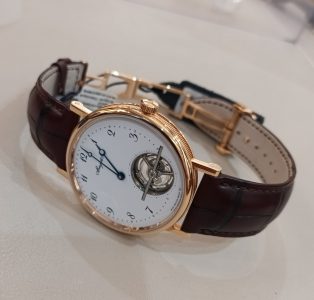Out of the three watches I was able to recently study at Berrys in York, this is the final and probably the most remarkable one!
Firstly, a little on Breguet – and I mean little, as, in a comparatively short article it is impossible to go into much detail on a business now well over 250 years old! So, I severely truncate and just mention some of the salient points.
Teenager Abraham-Louis Breguet travelled from his home in Neuchatel (Switzerland) to Paris in 1747 to commence a watchmaking apprenticeship. After successfully completing this, and then working for others in Paris, he set up his own workshop in 1775. By this time (due to help from some influential friends) he was now producing for the Royal Court and it’s associated aristocracy. However, matters were rudely interrupted by the French Revolution, and Breguet was forced to flee back home. Nonetheless, by 1795 he was back in Paris rebuilding his business. Over the next few decades he produced an extraordinary number of inventions – mainly of an horological nature. His legacy was massive, for which he had received numerous awards and accolades. A sample of his achievements included; the self-winding mechanism, Breguet hands and numeral design, repeater watch gong spring, guilloche and off-centre dials, the Breguet key and balance spring, constant force escapement, tourbillon regulator, chronometer for the French Navy, astronomical telescope, wristwatch, and the observation chronometer. He also made some stunning and very complicated timepieces. Phew!!
Abraham-Louis passed away in 1823 aged 76. His son Antoine-Louis takes over, and along with his son Louis-Clement, they continue to innovate and produce. However, some 50 years hence, the business was focusing less on time pieces and more on modern technology – such as electricity and, later, with aeroplanes. In view of this, in 1870, the business was sold to the head of the workshop, Edward Brown, who, with his family, continued in charge for another 100 years or so. In 1970, the Browns sold out to the French jewellery firm Chaumet, who in turn sold to InvestCorp in 1987. This marriage did not flourish, and InvestCorp (who also owned Ebel and Lemania. Ed), sold the brand to Swatch in 1999 under Nicolas Hyek. His grandson Marc is now the CEO.
Today, Breguet sits firmly at the top table of haute horlogerie, but, not actually at the head of it. This is still reserved jointly for the Holy Trinity of Patek Phillip, Vacheron Constantin, and Audemars Piguet. However, when one considers the huge history and contribution of Breguet, and their high quality output, some would say that they should be up there in, say, a quartet. My own view is that the various changes of ownership probably affected confidence and image – and possibly dampened creative output, whereas by comparison the other three have enjoyed comparatively stable histories with ongoing product evolution.
Regarding models, their gents range comprises of illustrious names such as Tradition, Marine, Type XX, and Classique. Within some of these, high complications abound – such as retrograde displays and tourbillons. For the ladies, the Reign de Naples range is popular – along with a bespoke haute joaillerie range. Additionally, Breguet also offers a range of jewellery and accessories.
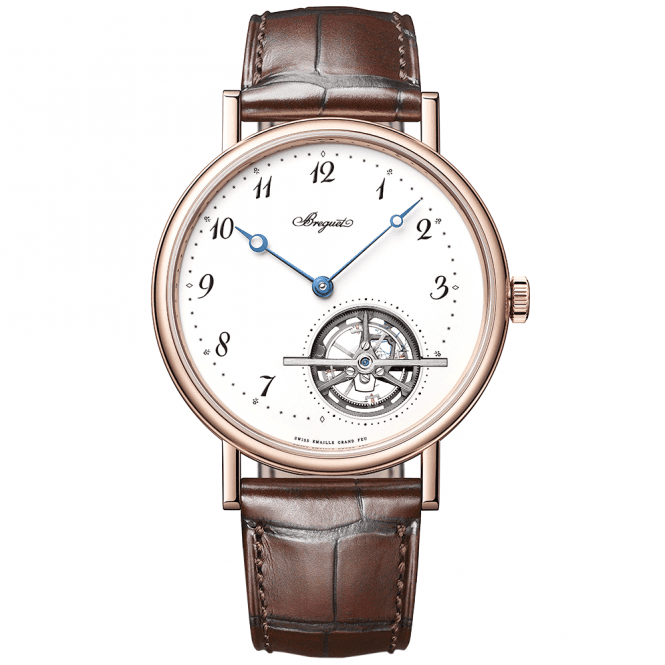
So, now we come to the watch in question. To give it its full name – Breguet Classique Tourbillon Extra-Plat (Extra-Thin) Gold (Ref 5367BR/29/(WU). So, a 42 mm x 7.45 mm round case in 18k rose gold. The case is polished and has a fluted (coin edge) band around the center. From the case fairly modest and straight-out lugs protrude, along with a traditionally-shaped and moderately-proportioned crown. The crystal atop is a non-reflective sapphire – as is the glazed case back. Water resistance of 30m is afforded.
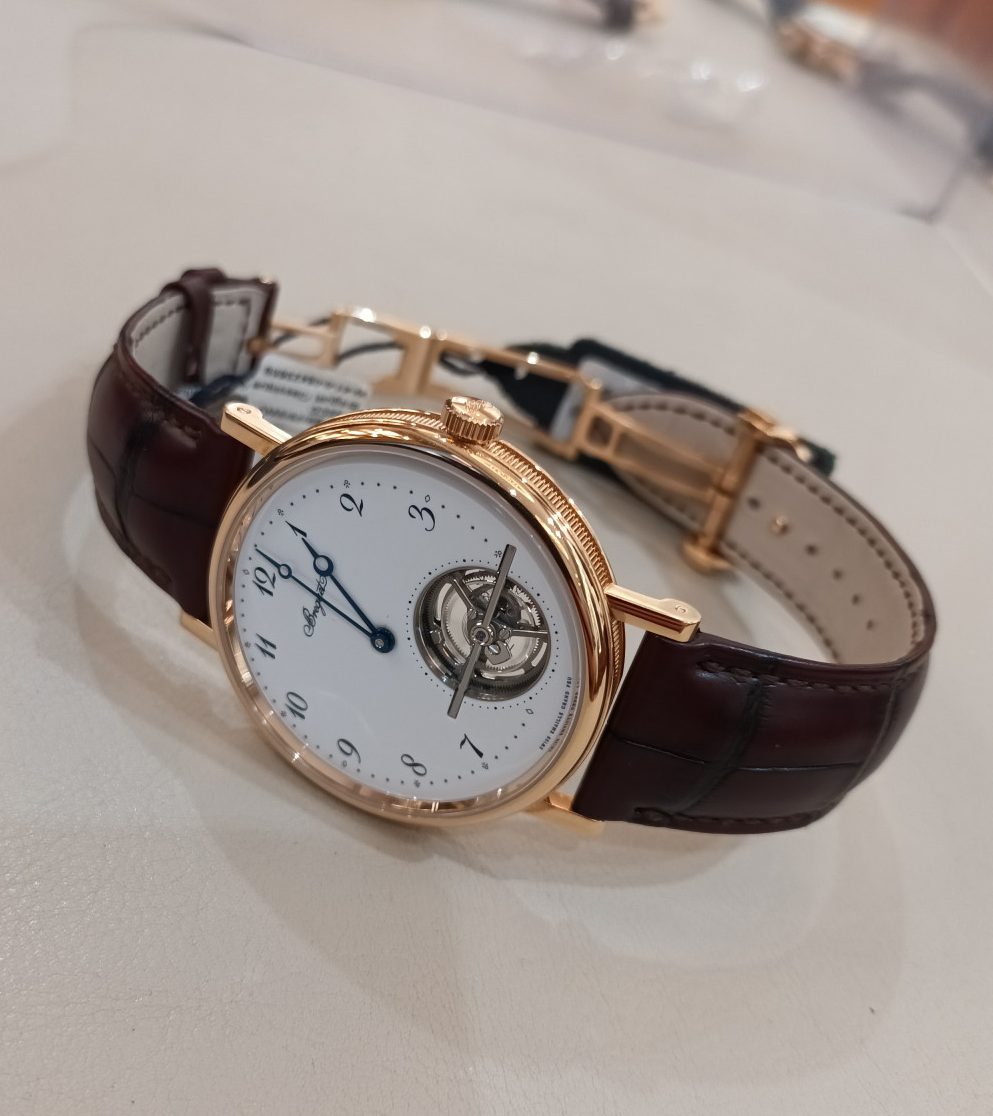
To the dial: This is a lovely white grand feu enamel item, with black Brequet Arabic numerals (save for 4-6), interspersed with hour marks and minute dots. “Breguet” is simply noted under the 12. The two hands – again in the Breguet style, are blued. The tourbillon and its aperture are at 5 o’clock, with the former secured by it’s horizontal bridge. It can also double as a running seconds register of sorts, being a one minute rotation organ. Although not visible in the images here, the dial does have the “secret Breguet signature” etched on the dial. This was a way of preventing copying back in the day!
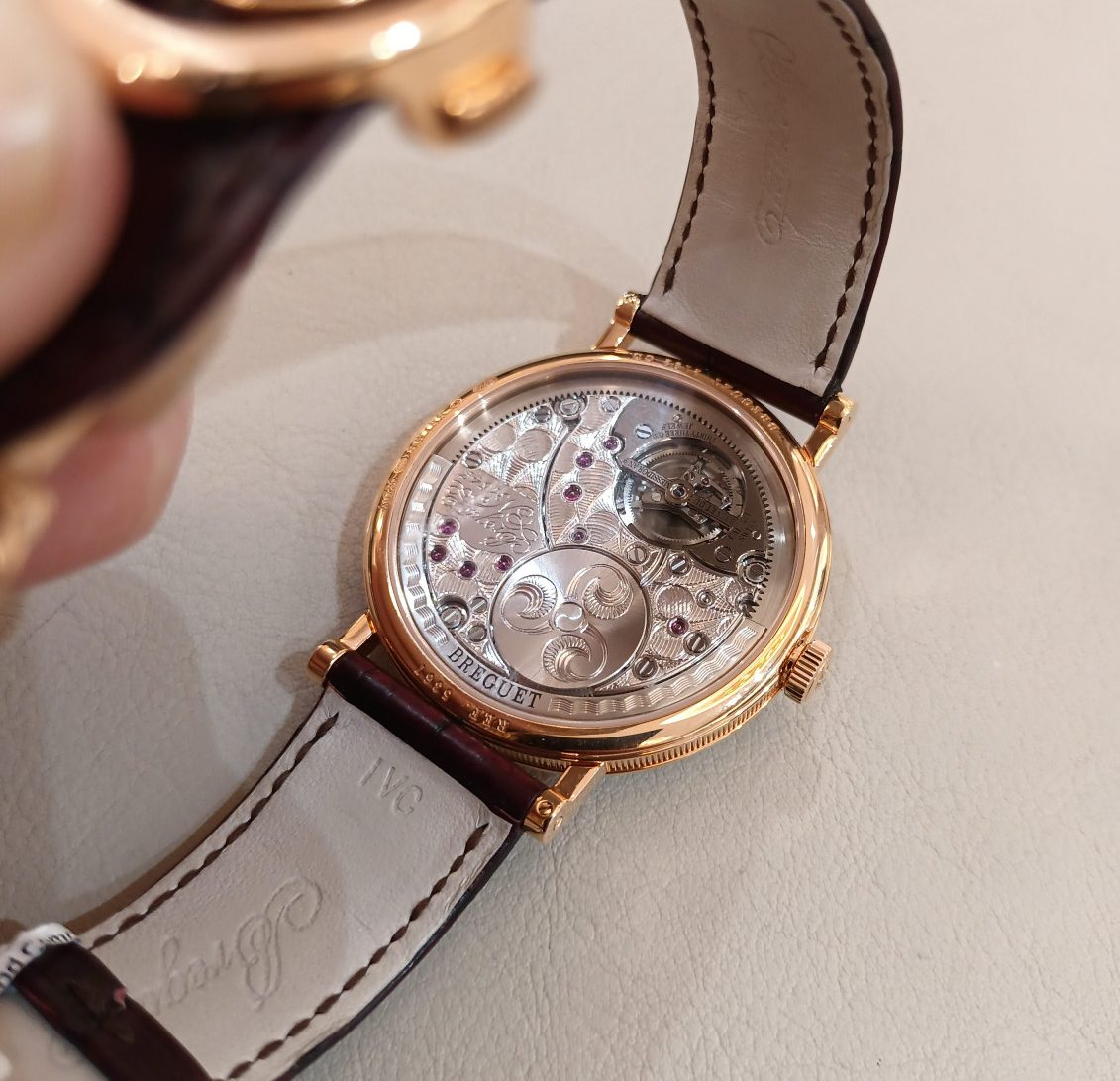
Turning the watch over reveals a simply stunning tableau of decoration. The latter encompasses baroque styling, but also perlage, anlage, waves – and frankly any other other designs/techniques you care to name. The platinum rotor is fascinating and very unusual, swinging on a series of miniature bearings at the outer case edge. In case you are confused, Breguet is engraved on it! It is basically a peripheral weight – well, I am calling it that. The motive power is from Breguet’s calibre 581, which boasts 334 components, including 33 jewels, inverted lateral lever escapement with silicon horns, silicon balance spring, and of course a Breguet balance wheel! The escapement is of a tourbillon type, and sits in a titanium carriage rotating at one revolution per minute. The beat is 4hz and some 80 hours of power is reserved. To note more achievement – the calibre is a slim 3mm, thus allowing the case to be a modest 7.45mm!
As the tourbillon is really the centrepiece of the watch, it is worthy of some separate comment. As mentioned earlier, the tourbillon was invented by Breguet back in the days of pocket watches. He had reasoned that there were several physical elements that could adversely affect a watch mechanism. One was the effect of gravity, and in the same breath component wear – both detrimental to accuracy. As such, he applied his not-inconsiderable mind to devising a device that would minimise the effects of gravity on the more sensitive parts of a watch.
In a little more detail: Consider, say, pocket watches. During the day they were kept upright in a waistcoat pocket, and at night hung at a similar angle on a stand – or simply flat on their back. This meant that the mechanism – and in particular the escapement components (so, in simple terms, the beating heart), must be slightly hampered by the effects of gravity pulling down. The solution, in some ways, was fairly simple and indeed logical. The affected components needed to experience as many positions as possible – whilst not relying on the position of the actual watch itself. Breguet’s answer was to place the whole escapement into a revolving “carriage” or “cage”. This itself rotated at one revolution per minute (later versions were one revolution per four minutes to counter a beat increase. Ed), so mimicking almost constant movement of the watch. Of course, the theory was great, but it was the application that was very difficult to achieve. However, as usual, Breguet succeeded, and in 1795 the first tourbillion was produced, with a patent granted in 1801. Incidentally, Breguet named his invention a tourbillon – meaning in French whirlwind (or maelstrom/vortex), so, it was most apt. Interestingly, a gold tourbillon pocket watch (ref 1297) was supplied to Kind George III in 1808, and on the dial is a tiny plate inscribed “Whirling About Regulator” – Breguet’s description of his tourbillon.
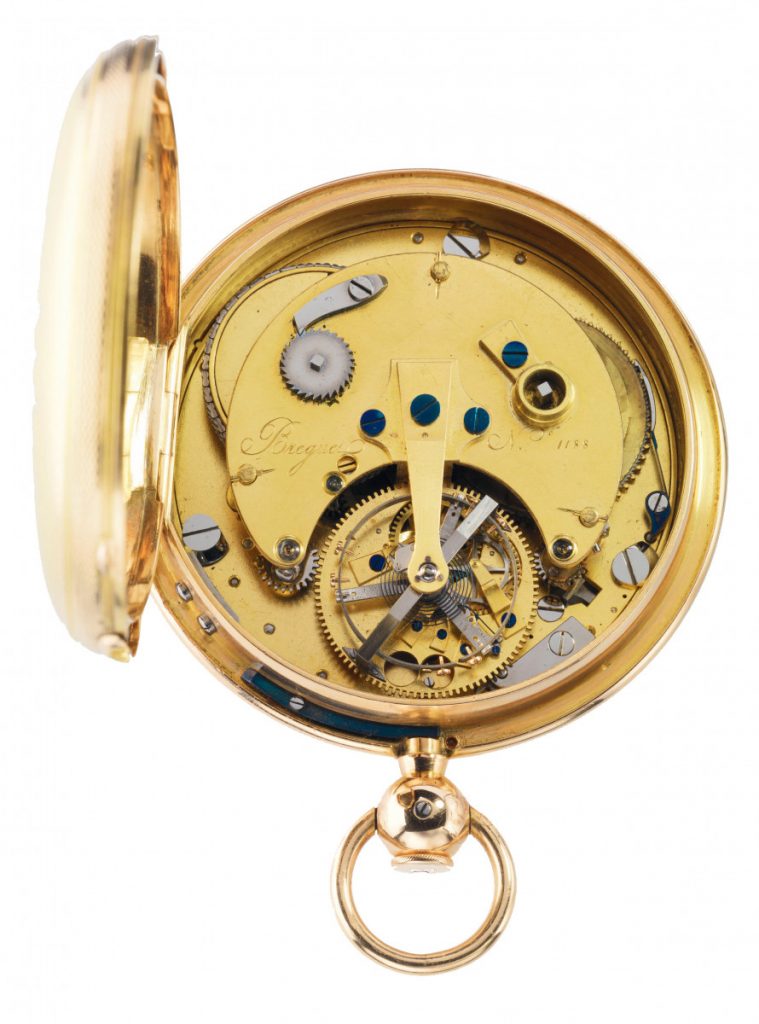
To the casual eye today, all this may seem a tremendous fuss to achieve what was really a marginal gain, and, up to a point this is true. However, back in the day, certain time pieces – like marine chronometers and deck watches, needed to be as accurate as possible in order to aid successful navigation. Lives literally depended on it. However, with the advent of wrist watches – which really came about after the 1st WW, the earlier rather static time pieces waned in demand, along with the tourbillon.
Today, most “standard” mechanical watches are in fact very precise, and those rated as chronometers (having passed stringent accuracy tests. Ed) will be at the pinnacle of accuracy. A few brands (mainly Breguet) have reintroduced tourbillons into their watches over the past decade or two, but only on very high value watches. In truth, this has more to do with technical prowess and aesthetics rather than hyper-accuracy.

Back to the watch; the whole ensemble is finished off with a classy brown alligator strap with a gold deployant buckle and Breguet button. This is secured to the lugs via screws.
So my thoughts? By any measure this is a truly fantastic and gorgeous watch! It is of very high quality and exudes a classy understated simplicity at the front, with exuberant decoration behind. Internally the mechanics are a very complicated piece of micro-engineering. All of this draws from a from a rich history.
But, after all the high praise, do I have any reservations? Well, as readers may recall, I am quite partial to symmetry. So, I like my chronographs to have two buttons, and my date windows at the main compass points. I also prefer balance in any registers too. So, here, I do feel that the overall look would be a little better if the tourbillon was, say, at 6 o’clock. Then, ahem, there is the price – which I will say very very quietly! £128,100. So, is it actually worth the money? Well, rather than answer directly – as I do not wish to appear unduly churlish, I just make a couple of observations: Firstly, we have already determined that there will be more accurate watches out there – such as pure high end chronometers – in precious metal too and for much less money. Secondly, compare this to the nearest “looking” watch in the Classique range – ref 5367BR/29/9WU. Also in gold, it has a white enamel dial and Breguet hands too. Obviously a different (but excellent) movement, and of course less decoration. This is £18,300. Yes, I know it is not the same, but can such a substantial price differential be justified? This question must be left hanging with you, dear reader, as such things can be very subjective. However, I must say that it is a shame that when a tourbillon is added to a watch (by most brands) it seems to inflate the price hugely, thus rendering ownership hopelessly out of reach for most people.
In conclusion, if you want a premier gold watch with a tourbillon – from the brand that invented it, then this must be a serious contender. One thing for sure is that you would probably be in a class of one within a room of watch collectors – if that is important. Finally, one thing I need to confess: I really would like one of these watches on my wrist, as the “Whirling About Regulator” is joyful to see – despite the price!
Rating: 4/5
Words/Images: The Writer – unless otherwise stated.
My thanks to Berrys in York.

